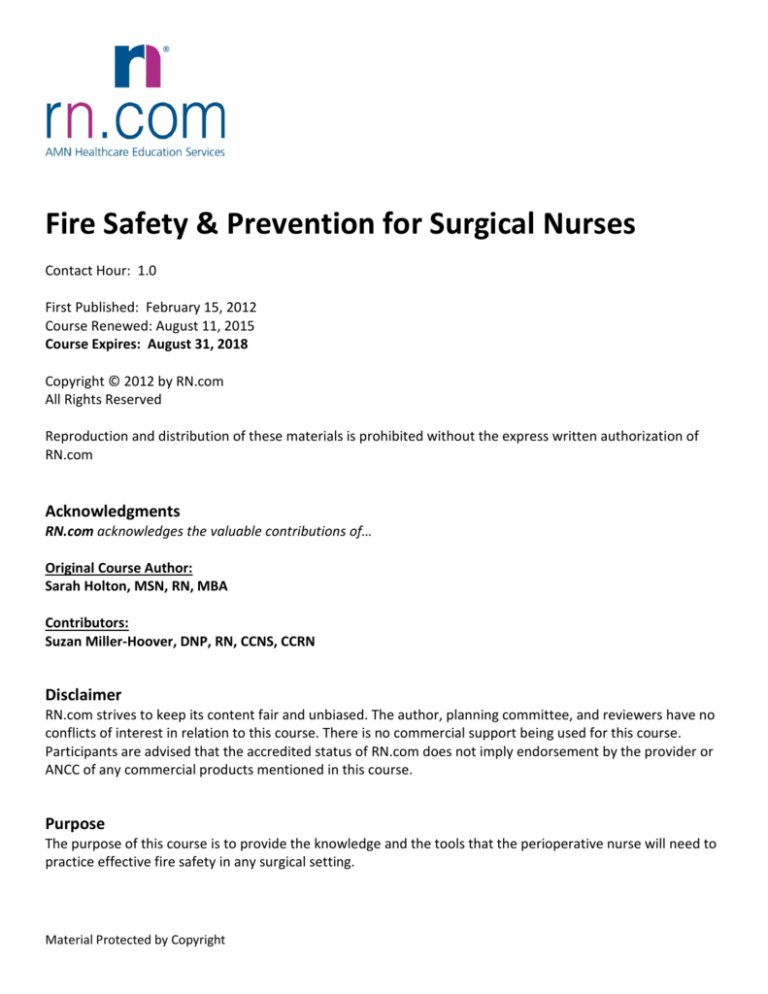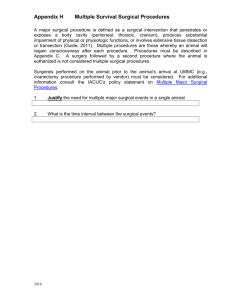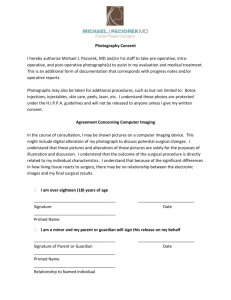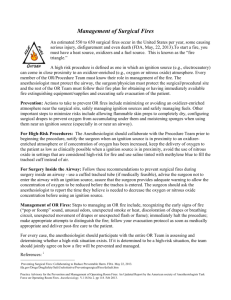
Fire Safety & Prevention for Surgical Nurses
Contact Hour: 1.0
First Published: February 15, 2012
Course Renewed: August 11, 2015
Course Expires: August 31, 2018
Copyright © 2012 by RN.com
All Rights Reserved
Reproduction and distribution of these materials is prohibited without the express written authorization of
RN.com
Acknowledgments
RN.com acknowledges the valuable contributions of…
Original Course Author:
Sarah Holton, MSN, RN, MBA
Contributors:
Suzan Miller-Hoover, DNP, RN, CCNS, CCRN
Disclaimer
RN.com strives to keep its content fair and unbiased. The author, planning committee, and reviewers have no
conflicts of interest in relation to this course. There is no commercial support being used for this course.
Participants are advised that the accredited status of RN.com does not imply endorsement by the provider or
ANCC of any commercial products mentioned in this course.
Purpose
The purpose of this course is to provide the knowledge and the tools that the perioperative nurse will need to
practice effective fire safety in any surgical setting.
Material Protected by Copyright
Learning Objectives
After successful completion of this course, the participant will be able to:
1. Identify the reasons for an increased risk related to surgical fires.
2. Describe goals of The Joint Commission Sentinel Event Policy.
3. Identify the three components in the fire triangle.
4. Identify responsibilities of each member of the surgical team in preventing fires.
5. Outline steps to treat a fire when fire exists.
6. Name the four components of the acronym “R.A.C.E.”.
7. Name the four components of the acronym “P.A.S.S.”.
Introduction
“Only YOU can prevent surgical fires” (ECRI, 2009). While fires within surgical suites rarely occur; annually over
550 surgical fires are reported in the United States (AORN, 2015). The first formal reporting of surgical fires
dates back to 1850; a fire erupted during a facial procedure using both ether and hot cautery (Macdonald,
1994). Despite the fact that the causes of surgical fires are well understood, they still occur (FDA, 2014). The
surgical team must be aware that the enriched oxygen and nitrogen atmospheres of the surgical suite increase
the flammability of drapes, plastics, and hair (ECRI, 2011a).
In 1994, the Joint Commission (TJC) recognized that careful investigation and evaluation of serious adverse
safety events (sentinel events) were essential to prevention of patient harm (The Joint Commission, 2014). TJC
defines a sentinel event as any event that reaches the patient and results in death, permanent harm, or severe
temporary harm and intervention to sustain life. Surgical fires are considered sentinel events.
Additionally, TJC determined that surgical fires meet criteria to be termed “never events” because they are
preventable if healthcare providers take appropriate steps to protect patients. All surgical fires can result in
considerable injuries or death, and this should never occur (ECRI, 2011b; Suchetka, 2010).
An Unfortunate Event
In 2009 a surgical fire was reported in the Internet Journal of Anesthesiology. The unfortunate events occurred
during the procurement of organs from a nineteen year old donor (Herman, Krzysztof, & Berger, 2009). The
young patient was determined to be brain dead three weeks after a motor vehicle accident. The patient’s
family, in an effort to turn an otherwise desperate situation into something more positive, requested that the
organs be donated. What unfolded next had potential consequences for not only the young patient’s family,
but also those now anxiously awaiting recipients.
At the start of the procedure, the surgeon cleaned the surgical site with a product commonly used in surgical
procedures which includes iodine povacrylex and approximately 75% isopropyl alcohol. The patient’s history
included sepsis; there was visible discharge from the tracheotomy site, causing the surgeon to wrap an alcohol
soaked sponge around the tracheotomy tube which was then left in place during the procedure.
Almost immediately after the procedure began, flames erupted from the patient. The team was able to
extinguish the flames with a bag of fluid and some ice chips; after having failed their initial attempt with a
towel, but the damage was already done. The patient now had burn injuries extending over the face, neck,
and shoulder covering an area 5 inches wide and 10 inches long.
Material Protected by Copyright
Fortunately, the event did not prevent the donation process from moving forward, nor did the young patient
suffer from injuries sustained in the fire. Unfortunately, it took this dramatic event to illustrate the need for
diligence when it comes to preventing surgical fires (Herman et al., 2009).
Test Yourself
The Joint Commission (TJC) determined that surgical fires meet criteria to be termed “never events”.
A. True
B. False
The correct answer is: True. Because they are preventable if healthcare providers take appropriate steps to
protect patients.
The Fire Triangle
The first triangle depicted shows the categories that must
be present for a fire to erupt, heat (ignition source), fuel,
and oxygen (oxidizer).
Prevention efforts starting from each of the three
categories must be reviewed and practiced routinely in
order to ensure a safe patient environment (AORN, 2015).
Test Yourself
Match the side of the triangle to the discipline that has the
most control of that category.
Ignition
Fuel
Oxidizers
Ignition
Fuel
Oxidizers
Anesthesiologist
Nurses
Surgeon
A. Nurses
B. Anesthesiologist
C. Surgeon
The correct answer is:
The Role of the Surgical Team in Fire Prevention
The entire surgical team plays an important role in fire prevention (AORN, 2015; FDA, 2014) and it is
imperative for each team member to understand how their role in the surgical procedure can contribute to
the fire triangle.
While each member of the team performs their specific role in the operating room, their activities can interact
with the activities of other team members and increase the fire risk.
Material Protected by Copyright
Imagine a three-legged stool. If one leg is missing it cannot stand. Just like the stool, there are three parts to a
surgical team that must come together in order to produce a result.
Understanding how the role and activities of the surgeon, the nurse, and the anesthesia provider interact can
prevent the deadly consequences of a surgical fire (AORN, 2015; FDA, 2014).
Taking Sides
As shown in the Fire Triangle, the surgeon is most frequently responsible for the ignition sources such as
electrocautery, direct lasers, and fiber optic light sources.
Anesthesia providers supply the oxidizers including oxygen, nitrous oxide, and medical compressed air. As the
final side of the triangle, nurses are often responsible for the fuels; including prepping agents, drapes,
sponges, and gowns (AORN, 2015; FDA, 2014). Communication is an essential part of surgical fire prevention.
Taking Ownership
While it is the responsibility of each of these key team members to manage their side of the triangle, the
individual must also to articulate the potential interactions their product or device has with the rest of the
team (Ouellette, 2011).
Heat and Ignition Sources
Heat serves as a catalyst to increase the oxidation rate of the fuel/oxygen mixture until a state of combustion
is achieved.
The following are a few ignition/heat catalysts:
• Electrosurgical units (ESU)
• Fiber optic light sources and cables
• Lasers
•
•
•
Drills and burrs
Argon beam coagulators
Overhead lights
Oxidizers
Oxidizers are the gases that can support combustion. The operating room suite is rich with these gases.
• Oxygen
• Nitrous oxide
Fuels
Virtually everything that comes into contact with the patient (including the patient’s own hair) is flammable
and may become fuel for the fire.
• Bone cement generates flammable fumes
• Chlorhexidine
while mixing
• Alcohol
• Dressings, sponges, drapes, plastics
• Hair
Material Protected by Copyright
Test Yourself
The operating room is equipped with which of the following items that may contribute to a surgical fire (mark
all that apply):
A. Oxygen enriched atmosphere
B. Alcohol based skin cleansers
C. Drills
D. Dressings
The correct answer is: all of the above.
Prevention
Prevention is the most important puzzle piece. It is important that the surgical team does not become
complacent about fire safety.
IT CAN HAPPEN TO YOU!
Each team member must be vigilant to processes that will prevent surgical fires. In addition to correctly
managing the fire triangle, the team should have a plan in place to ensure the team is competency validated in
surgical fire risk prevention and management.
Controlling Ignition/Heat Sources
The electrosurgical unit (ESU) is discussed in this example. It is essential that the patient is positioned and
draped to avoid sparking. The first intervention takes place before the patient is draped. Place the patient
return electrode on a large muscle mass close to the surgical site. This placement provides for the least
amount of resistance in the electrical circuit created as does keeping the active electrode cords from coiling.
These actions decrease the heat produced and the amount of power required to accomplish cauterization.
Storing the ESU pencil in a safety holster when not in use helps to keep the ignition source and the fuel
separated and decrease the potential for accidental activation of the active electrode.
Keeping the surgical drapes or linens away from activated ESU also keeps the ignition source and the fuel
separated. Moisten drapes if absorbent towels and sponges will be in close proximity to the ESU active
electrode.
You should use only active electrodes or return electrodes that are manufacturer approved for the type and
model of ESU being used because others may not fit correctly requiring a higher energy level or even create
sparks at the connection. The active electrode should be activated only when in close proximity to the target
tissue and away from other metal objects that could conduct heat or cause arcing therefore providing the
spark to cause a fire.
All devices with a heat source must be handled in such a way as to reduce the risk of fire. The person who is
controlling the heat source should be the only one who activates it. This can help to avoid accidental
activation which may result in a fire away from the surgical site. The team should ensure that the correct type
of fire extinguisher is readily available in the event of a fire.
Material Protected by Copyright
Did You Know?
The tip of the ESU pencil maintains heat event
after it is turned off?
The ESU unit is controlled by a foot pedal and
that foot pedal can be activated by anyone in
close contact?
Sparks occur when the ESU pencil inadvertently
touches another instrument, such as the clamp
near the vessel that is to be cauterized?
Controlling Oxidizers
It is important to note that ambient air, 21% oxygen, is not flammable. However, as the concentration of the
oxygen content increases, the temperature that is required to ignite the oxygen decreases. An oxygen
enriched atmosphere – greater than 21% oxygen –is easily created when concentrations of 30% or greater
oxygen are administered via an open delivery system and in a confined area. This is important because many
items will not burn in ambient air, but need as little as 26% oxygen to ignite, for example the endotracheal
tube commonly used in surgeries. According to the ECRI Institute and the Anesthesia Patient Safety
Foundation, fires in oxygen enriched atmospheres ignite more easily, burn hotter, and spread faster than fires
in other areas (ECRI, 2011a).
Interventions include administering the lowest amount of oxygen via mask or nasal prongs to the patient who
is not intubated that will support the patient’s physiological needs. Next, drape the patient so that the surgical
drapes allow sufficient venting of oxygen delivered to the patient. Additionally, use a separate administration
system to deliver 5 to 10 L/min of air under the surgical drape. This will help flush out the excess oxygen.
If greater than 30% oxygen is required, consider intubating with a cuffed endotracheal tube. The cuff helps
restrict the flow of the oxygen into the throat or into the surgical field. The supplemental oxygen or nitrous
oxide should be stopped for one minute before using an ignition source or for head, neck, or upper chest
procedures as the patient’s condition allows. This will also help to decrease the oxygen concentration in the
air under the drapes. Nitrous Oxide is another commonly used oxidizer. This gas, often called “laughing gas” is
administered via a face mask and can infiltrate the air around the patient. It is just as important to monitor
this gas as the other anesthesia gases and oxygen levels within the surgical suite.
Controlling Fuel Sources
Anything in the surgical suite may become fuel for a fire under the correct circumstances. Utilizing damp
towels and dressings increase the ignition threshold and decrease the risk that they will burn. When utilizing
Material Protected by Copyright
chemical agents such as alcohol-based skin prep agents or tinctures ensure they are completely dry. This
allows the fumes to dissipate before draping the patient and using an ignition source such as an
electrosurgical unit or laser. The fumes are the actual fuel which burns with some chemicals and any product
which contains alcohol.
Conducting a skin prep “time out” to validate that the prepping agent is dry before draping the patient is
another way to decrease fire risk. The Center for Medicare Services (CMS) has regulatory guidelines
surrounding the use of alcohol-based skin prep and hand hygiene products.
Guidelines
• Policies and procedures must be in place to reduce risk of fire
• Personnel must be aware of these policies
• Products are packaged for controlled delivery with clear directions that must be followed
• Documentation of implementation of fire prevention practices must be present in the patient’s
medical record
• Personnel must demonstrate practice of the policies & procedures (CMS, n.d.)
Test Yourself
The user of alcohol-based skin prep and hand hygiene products are regulated by a national agency.
A. True
B. False
The correct answer is: True. The Center for Medicare Services (CMS) has regulatory guidelines surrounding
the use of alcohol-based skin prep and hand hygiene products.
Managing the Process
Have a plan to fight the fire is one occurs. The time it takes to put the disaster plan into action can determine
the extent of the harm to the patient.
Communication is key. Knowing how to remove the patient from harm needs to be at the fore front of each
team members mind during a fire. The use of the following acronym will help team members remember their
immediate responsibilities in the event of a fire.
Immediately move the patient to the far side of a fire door, this will protect the patient from the immediate
danger from the fire. Calling for help is essential to prevent the spread of the fire. If the fire is small and can be
contained, such as a fire in a trash can, contain and extinguish it. However, if you perceive the fire too big for
you to extinguish, evacuate the team to safety.
Knowing how to use the rescue equipment is essential. When the need exists to deploy a fire extinguisher; the
acronym P.A.S.S. is useful to help the team member how to operate the extinguisher.
R.A.C.E.
R.A.C.E. stands for the following:
Rescue the individual that is involved in the fire.
Material Protected by Copyright
Alarm should be sounded as soon as possible.
Confine the fire.
Extinguish the fire and evacuate if required.
P.A.S.S.
P.A.S.S. stands for the following:
Pull the pin
Aim the nozzle at the base of the fire
Squeeze the handle
Sweep the stream over the base of the fire
CO2 Extinguishers
In the operating room, ECRI recommends a CO2 extinguisher. CO2 extinguishers expel a fog of cold gas and
snow that leaves no residue as it cools the fire. CO2 extinguishers are Class BC and are effective in flammable
liquids and electrical fires and have been shown to function well in Class A fires. Not all fires require an
extinguisher; use the most appropriate material to extinguish the fire, e.g. water or smothering (ECRI, 2011a).
Test Yourself
The acronym that guides the use of the fire extinguisher is:
A. R.A.C.E.
B. P.A.S.S.
The correct answer is: P.A.S.S. (Pull the pin, Aim the nozzle at the base of the fire, Squeeze the handle,
Sweep the stream over the base of the fire).
Practice Makes Perfect
Practice makes perfect. Because surgical fires are rare, the opportunity to learn how to react efficiently and
effectively to a fire is also rare. Therefore, the recommendation of AORN is to have your team participate in
regularly scheduled fire drills. A well-planned simulation of a fire in an operating suite will afford the operating
room staff an opportunity to practice and to see the results of their actions.
Knowing where the safe zone is before the fire occurs will help eliminate confusion. Where is the closest fire
door? Does the patient(s) need to move out of the operating rooms to the post-operative or pre-operative
areas? Where is the safest place? Do you have the right fire extinguisher? Does your staff know how to use
them? Does your staff know where the closest one is? Who does what? Does the nurse need to wait for
direction from the surgeon? From the anesthesiologist? The correct answer is: define your practice, develop
an action plan, and rehearse the plan.
Material Protected by Copyright
In the event of a fire, follow your institution’s disaster plan.
Conclusion
The Joint Commission and Centers for Medicare Services have regulations and guidelines to help hospitals and
surgery centers prevent patient harm. It is up to you to make sure you are doing all you can to protect your
patients.
Many safety hazards are present during surgical procedures and OR nurses must be diligent in protecting
patients from harm. Fire safety is a priority and nurses must act as leaders to ensure proactive fire safety
programs are established and practiced by the entire surgical team. With proper training and staff vigilance
virtually all surgical fires can be avoided.
References
AORN. (2015) Fire Safety Tool Kit. Retrieved from http://www.aorn.org/toolkits/firesafety/
CMS, State Operations Manual, Appendix A - Survey Protocol, Regulations and Interpretive Guidelines for
Hospitals. http://cms.gov/manuals/Downloads/som107ap_a_hospitals.pdf
ECRI Institute. (2011a). Surgical Fires.( Operating Room Risk Management, Volume 2, February). [Executive
Summary: Safety 1]. Plymouth Meeting, PA.
ECRI Institute. (2011b). Laser Use and Safety. (Health Risk Control, Volume 4, May).[ Executive Summary:
Surgery and Anesthesia 17]. Plymouth Meeting, PA.
FDA. (2014) Preventing Surgical Fires. Retrieved from:
http://www.fda/gov/Drugs/DrugSafety/SafeUseInitiative/PreventingSurgicalFires/default.htm
Herman, M., Krzysztof, L.& Berger, J. (2009 ). Surgical Fire During Organ Procurement. Retrieved from The
Internet Journal of Anesthesiology ISSN: 1092-406X,
http://www.ispub.com/ostia/index/php?xm1FilePath=journals/ija/vol19n1/fire.xml .
The Joint Commission. (2014). Sentinel Event Policy and Procedures. Retrieved from
http://www.jointcommission.org/Sentinel_Event_Policy_and_Procedures/
U.S. Food and Drug Administration. (2010) Safe Use Initiative: FDA-Sponsored Stakeholder Meeting on Surgical
Fire Prevention. Retrieved September 6, 2011 from http://www.fda.gov/Drugs/DrugSafety/ucm239511.htm.
Please Read
This publication is intended solely for the use of healthcare professionals taking this course, for credit, from
RN.com. It is designed to assist healthcare professionals, including nurses, in addressing many issues
associated with healthcare. The guidance provided in this publication is general in nature, and is not designed
to address any specific situation. This publication in no way absolves facilities of their responsibility for the
appropriate orientation of healthcare professionals.
Material Protected by Copyright
Hospitals or other organizations using this publication as a part of their own orientation processes should
review the contents of this publication to ensure accuracy and compliance before using this publication.
Hospital and facilities that use this publication agree to defend and indemnify, and shall hold RN.com,
including its parent(s), subsidiaries, affiliates, officers/directors, and employees from liability resulting from
the use of this publication. The contents of this publication may not be reproduced without written permission
from RN.com.
Material Protected by Copyright






